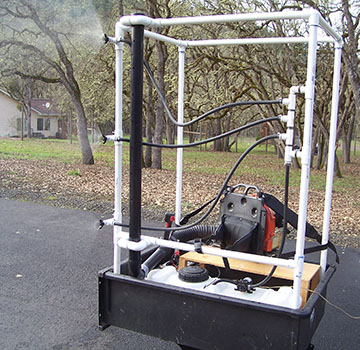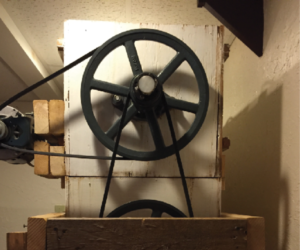I can still remember the days when my father served his wine straight from the “cellar.” It was really a cold room, which meant the temperature of the wine would follow our Montreal weather — very cold in the winter and hot in the summer.
As I moved into an apartment, and later on into a house, I stored bottles of wine in a closet with one wall adjoining an exterior wall. This was fine as long as I did not want to age the wine for more than a year or so, but my collection quickly outgrew any closet space in the house. As I had acquired some fine wines in the process, and built up a sizeable inventory of homemade wine, I needed another solution. I needed a bona-fide cellar that would protect my investment and reward me with the pleasure of drinking carefully-aged wine at its peak.
So I set out to learn as much as possible about building material properties, soil thermodynamics, and cooling and heating units. I wanted to build the perfect “cool” cellar. This knowledge and experience saved a lot of headaches and money compared to some of my earlier experiments.
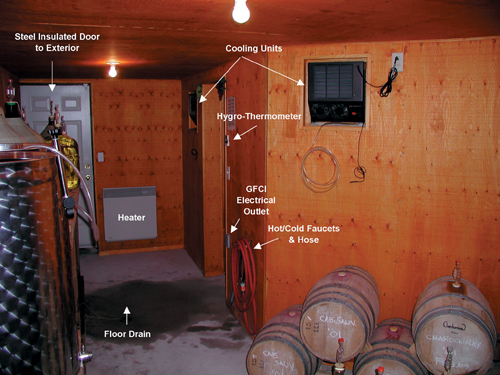
Depending on your needs, budget, winemaking volume and drinking habits, you don’t need to build that perfect cellar. Many options exist for storing wines. But if you do plan for that dream cellar, this guide will help you, too, save headaches and money.
You may also choose to seek the services of a building contractor and refrigeration specialist who can advise you on the proper design for your specific needs and environmental conditions. You will be able to ask — and receive answers to — all the right questions when consulting a specialist.
Planning Cellar Construction
Maintaining a constant cool temperature and a relatively high humidity are the most important environmental conditions to respect when building a cellar. The cellar should be free of vibrations and light sources that would otherwise accelerate the wine’s aging process. Therefore, avoid heavy-traffic locations such as a garage or under stairs, and store wine away from strong light sources — particularly from damaging UV sunrays. That’s why most bottles of commercial wine are tinted. When painting or varnishing cellar walls, avoid products with strong odors, which could otherwise penetrate bottles through and around the cork and negatively affect the wine’s taste and flavors.
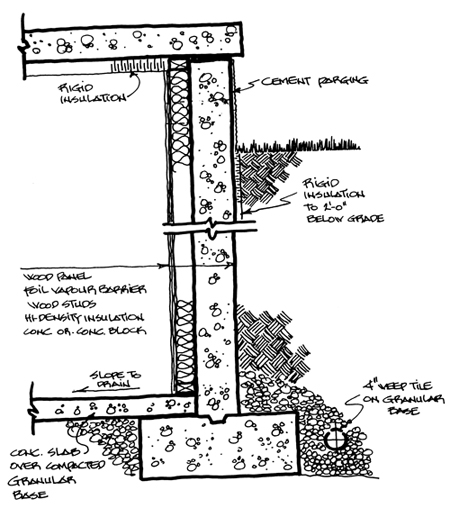
Temperature and humidity are most difficult to control because of the various sources of heat and cold around a cellar enclosure. The interaction between temperature and humidity — as well as the changing seasons — further complicate matters. Careful planning of temperature and humidity control will be critical in building an efficient cellar.
The ideal cellar temperature is in the 54–59° F (12–15° C) range and it must be kept constant throughout the year to ensure wine evolves slowly over time and develops its subtle flavors and aromas. As temperature increases, wine ages at a faster rate and must therefore be drunk earlier. If the temperature is too cold, then the wine is stifled and cannot evolve. Therefore, refrigerators or un-insulated cold rooms should not be used for wine storage, except for chilling bottles to be drunk within a few hours.
If temperature cannot be maintained at the recommended level, try not to exceed 70° F (21° C) and avoid large rapid swings which would negatively impact the wine. A constant higher temperature is preferable to letting it swing, for example, from 55° F (13° C) to 70° F (21° C) in the same day. The same swing over several months would be more acceptable, although not ideal.
The cellar enclosure should face as northerly as possible to minimize temperature variations from the sun. A cellar with below-grade walls will improve temperature-control efficiency since heat transfer between the cellar and its surrounding is minimized.
The cellar can be more tolerant to relative humidity, although extremes should always be avoided. Ideally, relative humidity should be in the 65–75 percent range. If it drops well below the minimum, say 40 percent, corks may start to leak because they may tend to shrink under drier air conditions. This is another reason why refrigerators are not appropriate.
Barrel wood will also shrink to create wide stave joints and start leaking. Bottle or barrel leakage will easily cause mold to form and spoil wine. If relative humidity gets too high, above 85 percent, the excess moisture in the air can cause mildew to form on corks and barrels. Such unsanitary conditions are a source of wine contamination when working in the cellar.
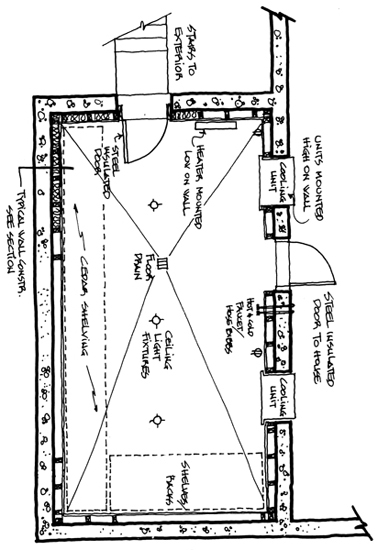
Mount a thermometer and hygrometer on a wall in the center of the cellar to monitor temperature and relative humidity. Handy digital hygro-thermometers capable of recording minimum and maximum temperatures and relative humidity can be purchased for approximately $30 (US).
Next, determine your electrical power requirements based on your design. Consult a qualified electrical contractor to help you determine your needs, and to perform all electrical work according to code.
At a minimum, you will need a separate 120V/15A circuit for lighting and outlets to operate pumps and other electrical equipment. This circuit should be equipped with a ground fault circuit interrupter (GFCI) to protect against accidents or electrical malfunction, for example, if water is accidentally splashed in the outlet. It’s easy to recognize a GFCI circuit in your house; it’s the outlet with “test” and “reset” buttons, which are usually colored black and red, respectively.
For lighting, 40-watt bulbs provide a good comprise between sufficient lighting and minimum heat dissipation. In larger cellars requiring more than one light bulb, use light fixtures with built-in switches to turn bulbs on and off individually in each work area. A good rule of thumb is to plan for one 40-watt light bulb per 60–80 square feet of cellar area.
If your cellar design will require hot- and cold-temperature control, you will need to plan separate circuits for your cooling and heating units. You will need either 120V/15A or 240V/15A circuits depending on the type of heating and cooling units chosen.
Controlling Temperature and Humidity
Temperature control poses quite a challenge because of the many sources of heat or cold that need to be monitored and adjusted. And if you live in a region with large temperature differences from one season to another, you need to implement solutions for controlling both low and high temperatures. The first thing you need to do is understand the temperature profile of the enclosure by monitoring and recording temperature readings throughout the year.
The best solution to control temperature is to install one or more cooling units specifically designed for wine cellars to operate at low temperatures and maintain the ambient relative humidity. Conventional room air conditioners are not recommended because they are not designed to operate continuously at very low temperatures. And since the cooling effect is achieved by removing moisture from the air, relative humidity drops down to undesirable levels. Borrowing cold or warm air from a central house system has the same disadvantages, and will never be able to meet the temperature needs of the cellar because the thermostat is set to control house temperature.
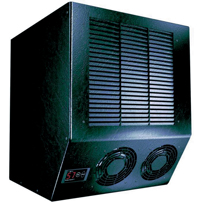
Koolspace cellar cooling units manufactured by Vintage Keeper are favorites amongst wine aficionados because of their “plug-and-play” feature. They are specifically designed for low-temperature cellar applications, maintaining the temperature within one degree and relative humidity in the range 40–80 percent. Relative humidity can be easily maintained around 65–70 percent with the proper cellar construction. Note that cellar cooling units are designed to remove warm air from a cellar and ventilate to an adjacent interior space; they should never be installed on an exterior wall for venting to the outdoors. Exposing a cooling unit to the elements will cause damage and void the warranty.
Several models are available to match different cellar capacities (volume) and are rated in BTUs (British Thermal Units), a measure of thermal energy. Manufacturers provide a chart listing volume and BTU for each model. To determine what model you need, calculate the volume of your cellar by multiplying its length, width and height. Adjust for any lost space, from a bay area, for example. Then simply match the result to the appropriate model. For example, if your cellar is 12 ft. long by 10 ft. wide by 7 ft. high, or 840 cu. ft., then you will need a Koolspace 900 model rated for up to 900 cu. ft. or 3500 BTUs. This model costs approximately $850 (US). If your capacity exceeds the highest rated model, you can add a second unit.
Breezaire is another manufacturer of cellar cooling units, including a split system that allows installation of the condenser up to 100 ft. away from the cellar, similar to home central air conditioning units. A split system is ideal where the cooling unit cannot be installed directly on a cellar wall because of venting limitations.
Cellar cooling units described above all operate on 120V/15A circuits. Plan for a separate circuit for each unit when installing two or more.
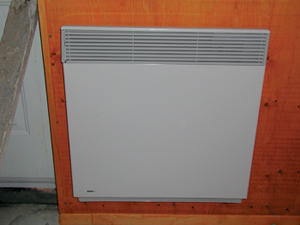
If you need to heat your cellar during the winter months, you will need to install a heater. Space heaters can do the job in small cellars but they are not designed for continuous operation. Another disadvantage is that the heating element and forced air consume moisture in the air, thus reducing the much-needed relative humidity. Warm air is also not distributed evenly throughout the cellar, therefore creating “pockets” of cold and warm air.
Convection-type heaters are the best solution because they distribute warm air evenly. They are quiet appliances because they do not have any fans, and their slim design greatly improves on cellar space. Your local renovation center should carry these types of heaters.
Convection-type heaters require a 240V/15A circuit and are rated in watts. Use approximately 1000 watts per 100 sq. ft. to determine your needs. For example, for a 12 x 10 ft. cellar, you will need a 1200-watt unit. You should be sure to install the heater closest to the source of cold air, such as next to the exterior door.
Insulation
Temperature-control units achieve maximum cooling or heating performance in a properly insulated enclosure. This means that you need to adequately insulate all walls, ceiling and doors. You also need to eliminate any source of air infiltration that would greatly compromise temperature control performance.
All walls, ceiling and doors must be insulated to a minimum of R-20 (R-30 is best). The R-value is a measure of the resistance to conductive heat flow through a material: The higher the R-value, the greater the insulating efficiency. For example, a one-inch material with a value of R-10 provides twice the insulating efficiency of an R-5 material. Walls should be framed using 2 x 4 ft. studs (2 x 6 ft. is best for exterior walls) spaced at 16 or 24 inches for installing the insulating material.
There are several choices of insulating materials depending on your cellar needs and budget. In order of increasing cost, they are: fiberglass or mineral wool thermal batts, polystyrene foam boards, or urethane/isocyanurate foam or boards. Material and installation costs vary widely as they are geographically sensitive. Visit your local renovation center and consult contractors to obtain material and work estimates.
Thermal batts, such as pink fiberglass insulation, are widely available at renovation centers. They are the lowest-cost solution and are very easy to install, although their low R-value, in the R-3 to R-4 range, would require six to 9.5 inches of insulation material. That would result in very thick walls, cutting down on precious cellar space. Batts are placed between wall studs and should be properly protected with a vapor barrier, such as polyethylene, on the inside wall (warm) surface to prevent condensation problems.
Extruded polystyrene foam insulation, such as blue styrofoam rigid boards, is rated at R-5 per inch, and is the alternative to thermal batts because of their higher insulation efficiency per inch. They also provide more resistance to moisture. For R-20 and R-30 insulating efficiency, you would need a foam thickness of four to six inches, respectively. You should also install 2 x 8 ft. or 4 x 8 ft. boards right against the wall to be insulated.
Urethane and isocyanurate insulation, rated between R-7 and R-8, provides higher efficiency for temperature and moisture control. Approximately 5 inches of foam is required to achieve R-30 insulating efficiency (an extra inch has been added to compensate for the drop in R-value due to material aging). 4 x 8 ft. foil-faced foam boards (the aluminum foil on each side of the insulating material acts as the vapor barrier) are easily installed up against the wall. Boards need to be fastened tightly as they tend to buckle.
Alternatively, you can opt for sprayed polyurethane foam, the material used in commercial walk-in refrigerators or refrigerated transport trucks. It is applied by spraying the foam directly on the wall. It quickly expands to fill cavities, and then hardens into a very dense and rigid material, adding structural strength. It also acts as an excellent vapor barrier while providing good soundproofing. You will need to call upon the services of a contractor for this work, making this the costliest solution.
Where possible, insulate the exterior face of outside walls (walls that are exposed to the elements) to improve temperature and humidity control in the cellar, especially in areas with wide seasonal temperature variations. For example, you can install one-inch-thick 2 x 8 ft. polystyrene foam boards below grade around the exterior perimeter of the cellar walls to keep low ground-frost temperatures away. Foundation walls should already be protected with a layer of tar to prevent water infiltration.
As for the cellar floor, a concrete slab is most practical, and does not require any insulation if the floor is below grade. If the floor is above grade, R-20 or R-30 insulation is required, and the water drain must be installed around waterproof flooring, such as ceramic tiles.
Consult a building contractor who can advise you on design and material required for your specific cellar requirements, which also must meet building regulations in your area. Most of the materials listed above must be covered with an approved fire-retarding material, such as gypsum boards.
Interior walls can be finished using moisture-resistant panels, such as cedar or redwood, or water-retardant gypsum boards (the ones with green paper on the faces). Use an odorless, non-water-based latex paint; the water content in paint will cause mildew to form on walls under high relative humidity in the cellar.
Exterior doors should be steel insulated with R-20 minimum protection and adequate weather-strips around the exterior perimeter to minimize air infiltration that would otherwise compromise the temperature-control efficiency of your cellar. Install a hydraulic door closer to ensure that the door is not accidentally left open. A doorstopper will be handy to hold the door open when carrying things in and out of the cellar.
Alternatives
There are no shortcuts to building a wine cellar that will provide a constant low temperature throughout the year. It will be an important investment, albeit an excellent one if you are a serious winemaker planning to age large inventories.
You certainly don’t need to invest in such a cellar. Any area in your house will do as long as you try to avoid large temperature fluctuations in a short period of time, although the aging period will be much reduced. Remember to pick a spot, such as a closet, where the exterior wall faces northerly, and where air is allowed to circulate freely.
If you also buy commercial wines and need to properly cellar these, another option is a temperature and humidity-controlled cabinet. It can be conveniently placed anywhere in the house and is available in various capacities, from a couple dozen to thousands of bottles.


